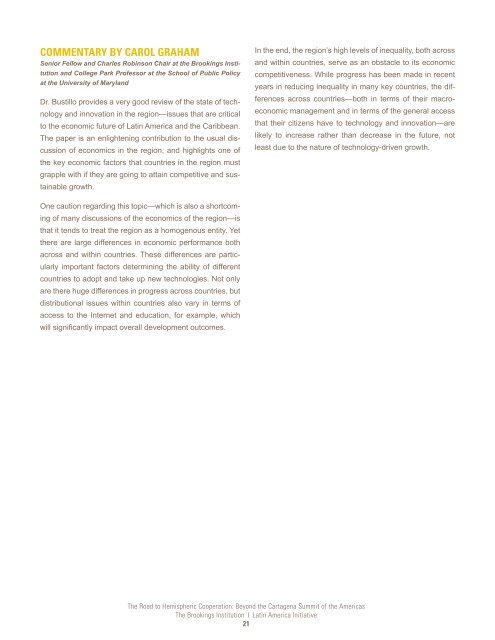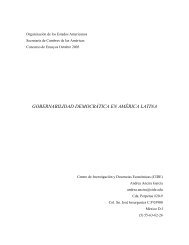The Road to Hemispheric Cooperation: Beyond the Cartagena
The Road to Hemispheric Cooperation: Beyond the Cartagena
The Road to Hemispheric Cooperation: Beyond the Cartagena
You also want an ePaper? Increase the reach of your titles
YUMPU automatically turns print PDFs into web optimized ePapers that Google loves.
COMMENTARy by CAROl gRAHAM<br />
Senior Fellow and Charles Robinson Chair at <strong>the</strong> Brookings Institution<br />
and College Park Professor at <strong>the</strong> School of Public Policy<br />
at <strong>the</strong> University of Maryland<br />
Dr. Bustillo provides a very good review of <strong>the</strong> state of technology<br />
and innovation in <strong>the</strong> region—issues that are critical<br />
<strong>to</strong> <strong>the</strong> economic future of Latin America and <strong>the</strong> Caribbean.<br />
<strong>The</strong> paper is an enlightening contribution <strong>to</strong> <strong>the</strong> usual discussion<br />
of economics in <strong>the</strong> region, and highlights one of<br />
<strong>the</strong> key economic fac<strong>to</strong>rs that countries in <strong>the</strong> region must<br />
grapple with if <strong>the</strong>y are going <strong>to</strong> attain competitive and sustainable<br />
growth.<br />
One caution regarding this <strong>to</strong>pic—which is also a shortcoming<br />
of many discussions of <strong>the</strong> economics of <strong>the</strong> region—is<br />
that it tends <strong>to</strong> treat <strong>the</strong> region as a homogenous entity. Yet<br />
<strong>the</strong>re are large differences in economic performance both<br />
across and within countries. <strong>The</strong>se differences are particularly<br />
important fac<strong>to</strong>rs determining <strong>the</strong> ability of different<br />
countries <strong>to</strong> adopt and take up new technologies. Not only<br />
are <strong>the</strong>re huge differences in progress across countries, but<br />
distributional issues within countries also vary in terms of<br />
access <strong>to</strong> <strong>the</strong> Internet and education, for example, which<br />
will significantly impact overall development outcomes.<br />
In <strong>the</strong> end, <strong>the</strong> region’s high levels of inequality, both across<br />
and within countries, serve as an obstacle <strong>to</strong> its economic<br />
competitiveness. While progress has been made in recent<br />
years in reducing inequality in many key countries, <strong>the</strong> differences<br />
across countries—both in terms of <strong>the</strong>ir macroeconomic<br />
management and in terms of <strong>the</strong> general access<br />
that <strong>the</strong>ir citizens have <strong>to</strong> technology and innovation—are<br />
likely <strong>to</strong> increase ra<strong>the</strong>r than decrease in <strong>the</strong> future, not<br />
least due <strong>to</strong> <strong>the</strong> nature of technology-driven growth.<br />
<strong>The</strong> <strong>Road</strong> <strong>to</strong> <strong>Hemispheric</strong> <strong>Cooperation</strong>: <strong>Beyond</strong> <strong>the</strong> <strong>Cartagena</strong> Summit of <strong>the</strong> Americas<br />
<strong>The</strong> Brookings Institution ❘ Latin America Initiative<br />
21








